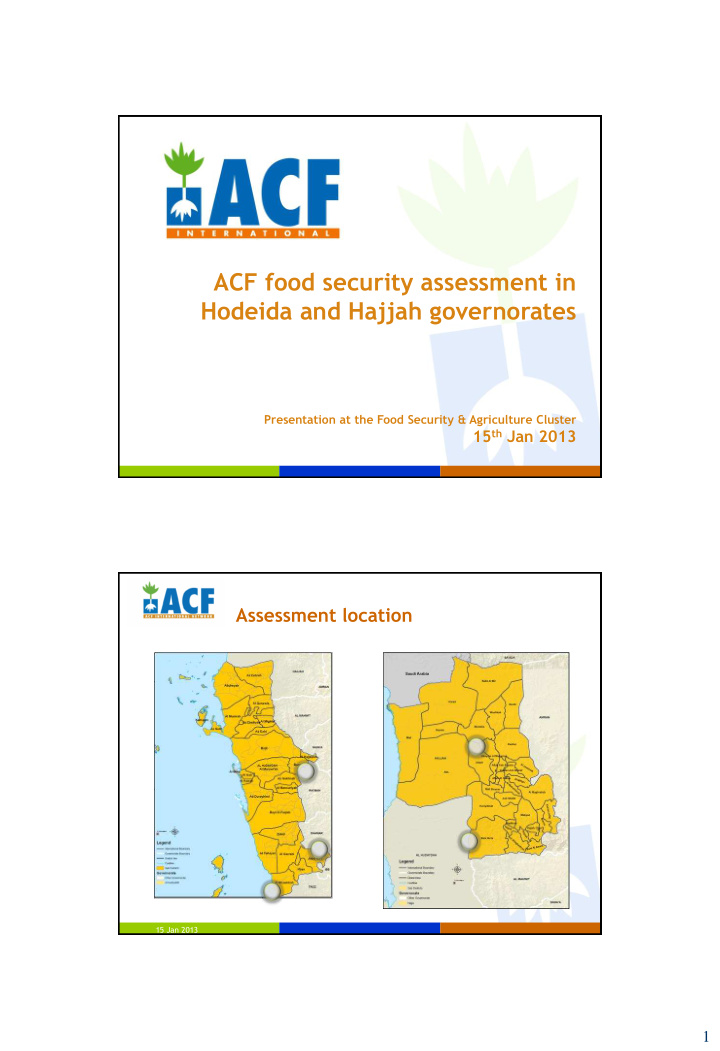



ACF food security assessment in Hodeida and Hajjah governorates Presentation at the Food Security & Agriculture Cluster 15 th Jan 2013 Assessment location 15 Jan 2013 1
Assessment tools District # Households Market Key informant Focus Group interviews surveys interviews discussions Al Khawkhah 87 (68 Male HH; 3 5 10 (5 male, 5 19Female HH) female) Jabal Ras 132 (97 male HH; 35 7 7 10 (5 male, 5 Female HH) female) Bura 134 (96 male HH; 38 7 6 10 (5 male, 5 Female HH) female) Aslem 138 (100 male HH; 38 3 5 14 (8 male, 6 female HH) female) Bani Qais 214 (146 male HH; 68 6 6 10 (6 male, 4 Female HH) female) Totals 705 HH (507 male 26 29 54 (29 male, 25 HH; 198 female HH) female) 15 Jan 2013 Findings: Demography, Household & community profile Female-headed households: 26.3% in Hodeida; and 30.1% in Hajjah No formal education: 74.8% in Hodeida and 71% in Hajjah Children: 57.9% in Hodeida and 61.8% in Hajjah of surveyed household members Adult of productive age: 36.9% in Hodeida and 34.1% in Hajjah (very high dependency ratios, exceeding 60% in both governorates) Average household size: 7.8 members in Hodeida and 7 in Hajjah 15 Jan 2013 4 2
Land ownership 90% 77% 80% 74.30% 69.40% 66.70% 70% 60% 50% 44.70% 40% Own land 30% Landless 20% 10% 0% 15 Jan 2013 5 Utilisation of harvest 76.5% in Hodeida and 84.3% in Hajjah of all harvested produce consumed at the household level 5.7% in Hodeida and 4.5% in Hajjah of harvest used as livestock fodder Harvest not sufficient to meet household food needs – meet an average of 3 months needs only Rely on market produces for the rest of the months 15 Jan 2013 6 3
Livestock Production 66% in Hodeida and 75% in Hajjah of households keep one form of livestock or another Households benefit from a “unique livestock arrangement” where influential people give out their livestock to be taken care (50:50 sharing) Challenges faced: • Access to grazing land: 75.1% in Hodeida & 57.7% in Hajjah • Access to vet services: 54.9% in Hodeida and 32.8% in Hajjah • Access to water points: 21.5% in Hodeida 15 Jan 2013 7 Months of adequate household food provisioning (MAHFP) 120.00% 100.00% 80.00% 60.00% Less than 9 mths More than 9 mths 40.00% 20.00% 27.40% 27% 24.80% 19.50% 12.50% 0.00% Al Khawkhah Jabal Ras Bura Bani Qais Aslem 15 Jan 2013 8 4
Sources of income Dependence of poor households on selling their labour is high: 31.5% in Hodeida and 43.6% in Hajjah Remittances account for sizeable amount of income: 11.5% in Hodeida and 24.2% in Hajjah Sale of livestock and livestock related products accounts for 10% in Hodeida and 12% in Hajjah 9% of households in Hajjah depends on gifts and aid as their predominant income source Al-Khawkhah main income source for 35.7% of the households surveyed is sale of fish and fishery related products 15 Jan 2013 9 Households Expenditure patterns Food is the single biggest monthly expenditure item across all districts (78.3% in Hodeida and 80.7% in Hajjah) Health-related expenditures: about 7.8% in Hodeida and 7.4%. Other expenditures: Education (2.5%); transport (2.3%) Qat expenditures: 3.8% in Hodeida and 1.7% in Hajjah 15 Jan 2013 10 5
FCS: Food Security status District Severely food insecure Moderately food Food secure (poor) insecure (borderline) (acceptable) Al-Khawkhah 15.3% 29.4% 55.3% Jabal Ras 13.6% 34.8% 37.8% Bura 23.6% 37.8% 38.6% Bani Qais 22.9% 39.5% 37.6% Aslem 23.3% 43.6% 33.1% • 168,476 persons in these districts are food insecure (severely and moderately). • 57.3% of female headed households were food insecure as compared to 50.5% male-headed households in Hodeida . For Hajjah: 66.3% FHH as compared to 59.2% MHH 15 Jan 2013 11 Coping mechanisms During the course of the preceding week, 28.6% of households in Hodeida and 19% in Hajjah experienced difficulties in accessing enough food. Most prevalent food related coping strategies adopted was: relying on less preferred food (5.9 days); purchasing food on credit (5.2 days); limiting portion size at meal times (4.8 days) and sending household members to beg (4.6 days) No significant difference in coping strategies between male and female headed households. Most significant livelihood coping strategy was migration (25.8% in Hodeida, 19.6% in Hajjah with 51.4% in Hajjah and 24.2% in Hodeida of this migration been to outside Yemen Women rendered de-facto household heads due to this migration 15 Jan 2013 12 6
Recommend
More recommend